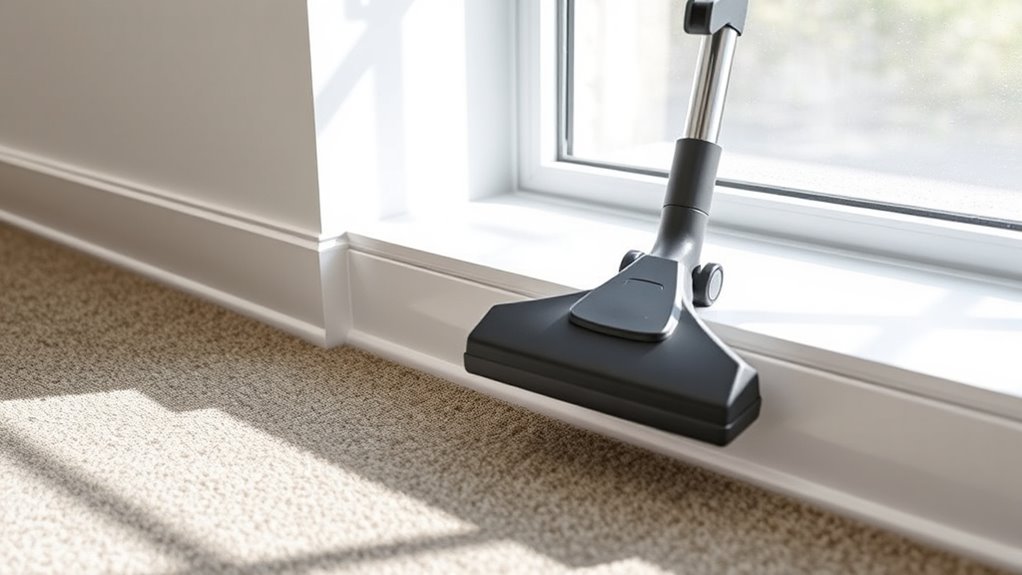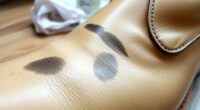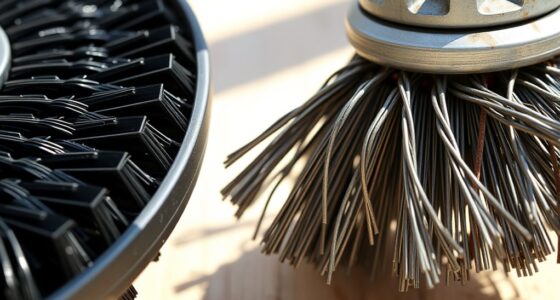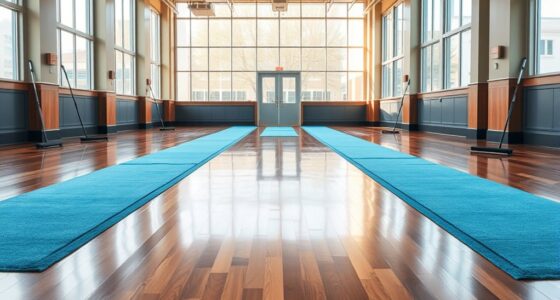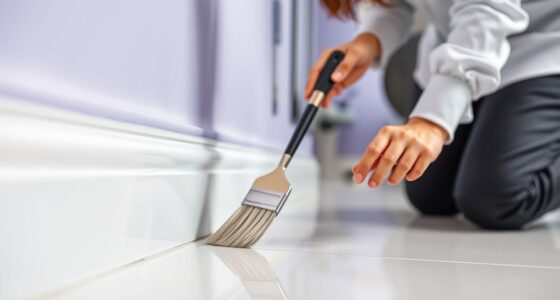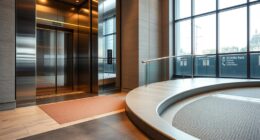To master edge cleanup in classrooms, focus on using microfiber mops angled along baseboards with gentle, slow strokes for thorough dirt removal. Use detail brushes or angled dusters to reach tight corners and tricky spots, then wipe residual dust with a damp cloth for a spotless finish. Regularly inspect and touch up paint chips to keep edges looking fresh. Keep practicing these pro tricks, and you’ll discover more tips that make your cleaning faster and more effective.
Key Takeaways
- Use microfiber mops angled along baseboards with gentle pressure for thorough dust removal.
- Employ detail brushes or angled dusters to reach into tight corners and along edges effectively.
- Dampen tools slightly to enhance dirt pickup without causing water damage.
- Perform regular paint touch-ups on baseboards to prevent dust accumulation on chips or scratches.
- Incorporate consistent edge cleaning into routine maintenance to prevent dirt buildup and maintain a polished look.
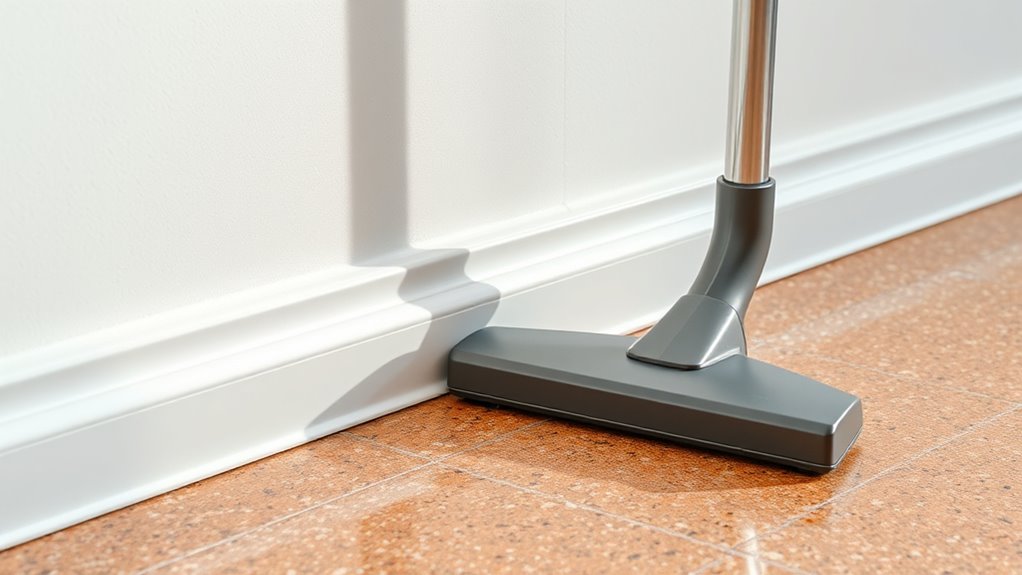
Have you ever noticed how dust and debris tend to gather along the edges of classroom floors and furniture? It’s a common issue, and addressing it effectively can make a significant difference in the overall cleanliness of your space. When it comes to edge cleanup, mastering the right techniques is essential, especially around baseboards and corners. Using proper mop techniques is vital to remove dirt without spreading it around. Instead of just dragging a mop randomly across the floor, focus on angling the mop head along the edges, applying gentle pressure to lift dust and debris from the baseboards and corners. Microfiber mops work best because their fibers trap dust efficiently. For stubborn spots, dampen the mop slightly—not too wet—to prevent water damage and guarantee thorough cleaning. Moving in slow, deliberate strokes along the baseboards ensures you pick up every speck of dirt lurking in those tight spaces. Additionally, understanding cleaning techniques can help optimize your efforts and prevent cross-contamination during cleaning routines.
In addition to mopping, paying attention to paint touch-ups can help maintain a polished appearance, especially on baseboards that see frequent contact and scuffs. Small chips or scratches can collect dust and become more noticeable over time. Regularly inspecting these areas and performing quick touch-ups with matching paint can make your classroom look fresh and well-maintained. Use a small brush or a fine-tipped applicator for precision, and always clean the area beforehand to guarantee the paint adheres properly. Touch-ups aren’t a substitute for regular cleaning but serve as a finishing detail that keeps the edges looking crisp and tidy.
For more efficient edge cleanup, consider using tools like detail brushes or angled dusters that fit snugly into corners and along baseboards. These tools can reach into tight spaces where a mop might not fit comfortably. Once dust and debris are removed, you can go over these areas with a damp cloth to pick up any remaining residue, ensuring a spotless finish. Incorporating these techniques into your routine saves time and improves the cleanliness of your classroom. Remember, consistency is key; regular edge maintenance prevents buildup and makes deeper cleaning sessions less intimidating.
Frequently Asked Questions
What Tools Are Best for Quick Baseboard Cleaning?
The best tools for quick baseboard cleaning are a microfiber cloth and a vacuum with a brush attachment. The microfiber cloth efficiently removes dust and dirt from the surface, while the vacuum quickly clears debris from corners and edges. Using these tools together maximizes dust removal and guarantees you work efficiently. You’ll find that this combo saves time and keeps your baseboards looking spotless with minimal effort.
How Often Should Classroom Baseboards Be Cleaned?
Meticulous maintenance makes a difference! You should clean your classroom baseboards weekly to prevent dust accumulation and stubborn stains. Regular cleaning keeps them looking fresh and free of grime. By consistently tackling dust and stains, you maintain a healthy, hygienic environment for students and staff. Don’t wait for dirt to build up—staying proactive with a quick wipe guarantees your baseboards stay bright, beautiful, and bacteria-free all year long.
Are There Eco-Friendly Cleaning Solutions for Baseboards?
Yes, there are eco-friendly solutions for cleaning baseboards. You can use natural cleaning methods like mixing white vinegar with water or creating a baking soda paste to effectively remove dust and grime. These natural cleaning options are safe for the environment and your classroom’s air quality. By using eco-friendly solutions, you guarantee a healthier space for everyone, while still maintaining clean, shiny baseboards with minimal chemical impact.
Can Students Help With Baseboard Maintenance?
Absolutely, students can become the guardians of your baseboard maintenance routines. Imagine them as tiny custodians, wielding cloths like magic wands to sweep away dust and dirt. Their involvement not only lightens your load but also teaches responsibility. By encouraging student participation, you turn routine cleaning into a team effort, transforming mundane tasks into a shared mission to keep the classroom sparkling and inviting for everyone.
How to Prevent Baseboards From Getting Dirty Quickly?
To prevent your baseboards from getting dirty quickly, regularly clean and paint them to create a protective barrier against dust and stains. Use mold prevention techniques by keeping the area dry and well-ventilated, especially in humid environments. Applying a fresh coat of baseboard paint not only refreshes their look but also helps repel dirt buildup. Consistent maintenance guarantees your baseboards stay clean and mold-free longer.
Conclusion
Think of edge cleanup as tending a garden—you carefully trim the weeds and tidy the borders to keep everything looking neat and inviting. When you master these baseboard tricks, your classroom becomes a well-kept sanctuary where every detail shines. With each sweep, you’re not just cleaning; you’re shaping a space that feels fresh and cared for. Keep honing your skills, and you’ll turn every corner into a polished masterpiece, ready to inspire learning and creativity.
